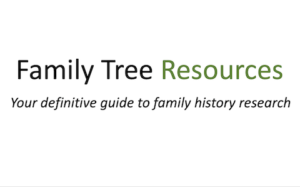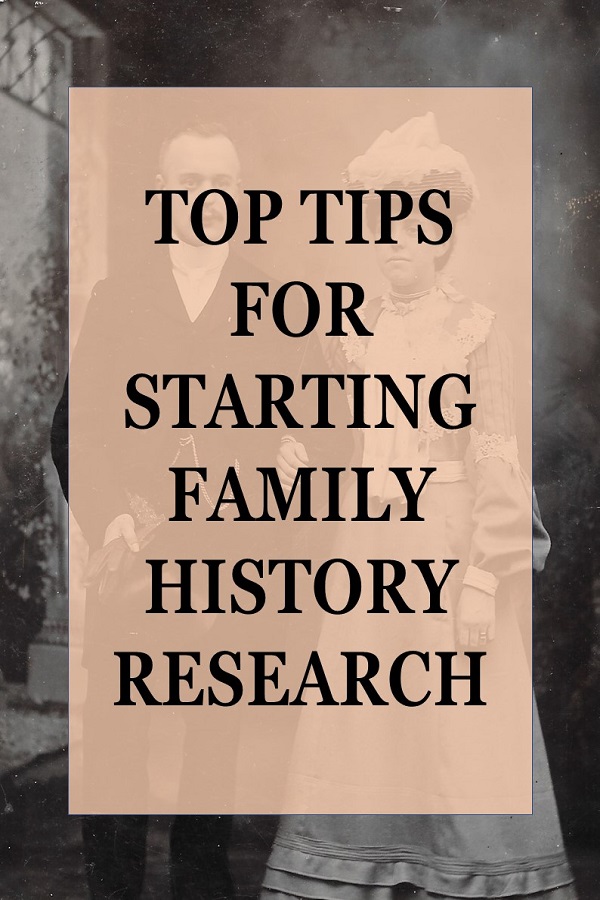
Starting Family History Research can be the beginning of a wonderful adventure – an adventure that takes you on a magical journey of discovery back to the past.
When you begin researching your family tree, one of the most important things to do is to talk to your immediate family. They often have memories of the family that are imperative when you begin your journey. They may also have certificates that will prove useful to your research.
You should begin by noting down everything you already know about the family, such as the names and birth dates of your parents and grandparents etc, adding a question mark by any details you are unsure of.
You can use this information to draw a basic family tree, which will become the starting point of your family history research journey.
A family tree is a diagram showing how members of your family are related to one another. You should start with yourself, and if you are married, you should place your husband’s/partner’s name next to yours, denoting the union by placing = or ‘m’ between the two names.
If you have children, these should be placed underneath you, marking the connection by drawing a connecting line between you. You should do the same with your parents and grandparents; if you know the names of all your grandparents, you will end up with four names on your family tree.
You can already see how big your family tree could possibly become because you are effectively doubling the number of ancestors for each generation you work back. You will have 8 great-grandparents, 16 great-great grandparents and so on.
If you choose to print off your family tree, you may find you have to use more than one sheet of paper!!
If you know information such as women’s maiden names, you should add these details as it will help you determine if you have found the correct people when you begin your research.
As you can see from the basic family tree below, I have used some abbreviations, such as b for born, m for married, and d for died.
You can also see that even just going back to my grandparents that they have come from all around the United Kingdom – from Kettering, Northampton, Battersea, Catford and Leeds.
Battersea (Surrey) is in London, as is Catford (Kent), whereas Leeds is in Yorkshire and Kettering in Northamptonshire.
Knowing where your ancestors come from is crucial to ensure you have found the correct people, especially if they have a more common surname such as Smith.
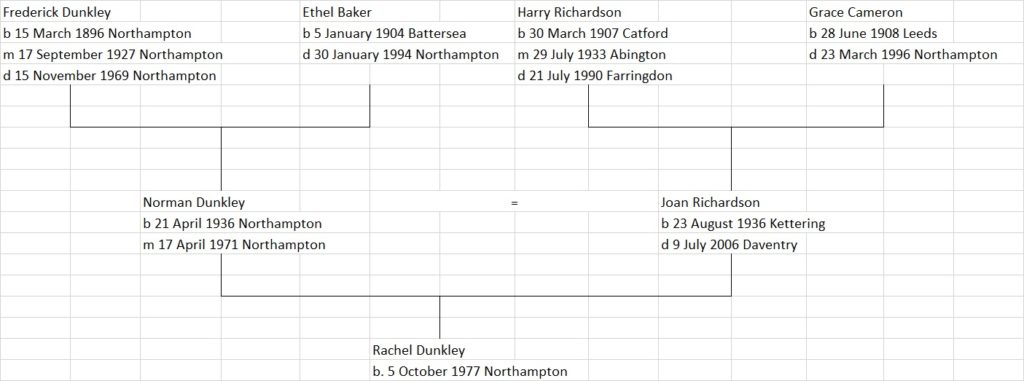
Interview Family Members Before Researching Family History
You should interview older relatives asking what they remember about their own parents and grandparents and also ask them if they have any copies of birth, marriage or death certificates.
Your older relatives may give you details of family rumours that you find fascinating and want to investigate. It is prudent to record the conversations (remember to ask them if they would mind the conversation being recorded!) that you have with your relatives so that you have a record for the future.
One of my biggest regrets is that I did not ask my grandparents about their memories of the family, and now that they are gone, all their memories have gone with them.
If your family members are still alive, please ask them about the family – if you leave it, it may become too late!!
For more information about how to find your ancestors’ parents, please read my article: how to find an ancestors’ parents
My grandmother (Nana) on my Mum’s side kept many original birth, marriage and death certificates, which I now have in my possession.
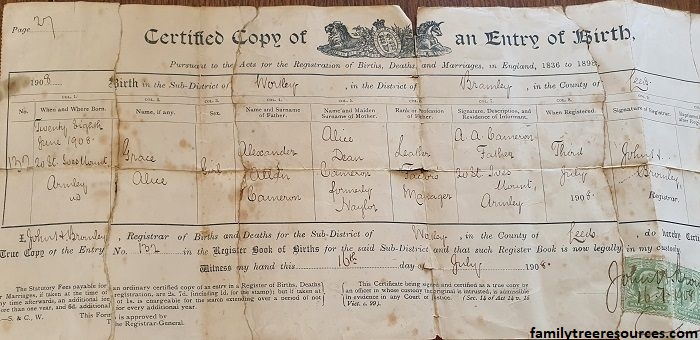
This birth certificate is that of my grandmother Grace Alice Cameron. It shows that she was born on 28 June 1908 and that her father was Alexander Allan Cameron and her mother was Alice Dean Cameron née Naylor.
These certificates will become the starting point for your research and can give you the information you need to continue your family history research journey. Who knows who you will discover??
Your relatives may also have newspaper cuttings, diaries, letters, photographs, journals and other documents relating to your ancestors. For more information about discovering family photographs, please read my article: how to find old family photos
First-hand accounts from family members can be a very useful resource when you are beginning your research, but please remember that there may be skeletons in the cupboard – this is probably the case in every family.
When I conducted my own family history research I discovered that my grandma’s parents never actually married.
Your relatives could have a family bible or other religious book passed down through the generations so it is worth checking if there is a family bible when you are interviewing family members – you may find details about your ancestors have been written into the pages of the book.
As the details were probably written from memory, you should always try and substantiate the information by checking official records.
As you can see in the bible extract below, Mary’s marriage date is given as 1892.
It required further investigation to determine Mary Florance Adams married Henry Thomas Richardson on 16th December 1893 and not 1892.
This was probably to hide the fact that Mary was pregnant when she got married as Lily was born on 30 May 1894!!
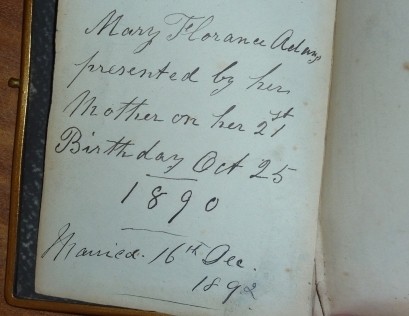
From the details written in the Book as per the extract above, we know Mary was probably born in 1869, and investigation has proven this information to be correct as Mary Florance Adams was born on 25 October 1869.
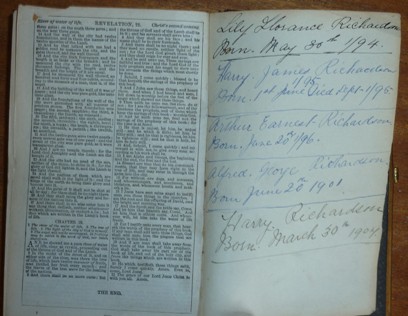
Her children with Henry Thomas Richardson were also written into the bible and investigation has shown the information was correct.
I obtained the birth certificates for Lily Florence Richardson, Harry James Richardson, Arthur Earnest Richardson, Alfred George Richardson and Harry Richardson (my grandfather). The death date of Harry James Richardson was also correct.
Document Your Family History Research
A great way of doing this is to use a USB flash drive for documents and information held on a computer. I personally use the 32GB SanDisk Cruzer Blade, which I find does the job very well. It comes in many different capacities, so you can choose the drive which best suits your needs.
It is important to know precisely how you will document your family history research at the beginning of your journey.
For tips regarding how to record your family history research, such as how to organise your research and whether to use a card index system or a computer software program, please read my article: recording your family history: why organising research is important.
To discover more about the charts you can use to document your research, please peruse my article: family history charts.
One of my favourite ways of keeping track of my research is to use a research log because you can use it to note all the records you have researched.
This should include the source (s) consulted, the name of the person you are researching, the years you researched, and the details you uncovered.
This makes it easier to show your research to someone else and to ensure you do not look at the same record multiple times. I have designed a research log that you are quite welcome to use to document your own research.
Finding a Woman’s Maiden Name Crucial to Family History Research
It is up to you to decide which avenue you wish to explore first – whether to start with your father’s or mother’s line or investigate a line which has a more unusual surname, which could be easier to trace, but this is not always the case.
Finding a woman’s maiden name can be crucial to furthering your family history research because this can help you to prove if you are researching the correct family.
If there are two George and Ann Heel’s, and you need to know which couple are your ancestors, finding the woman’s maiden name can help you to determine the correct line. To discover more about discovering a woman’s maiden name, please read my article, finding a woman’s maiden name.
What you think is an unusual surname may not be as unusual as you think. Believe me, I have found that to be the case on numerous occasions!! Some brick walls you may encounter in your research could be broken down by using some of my genealogy tips.
I have also written a page regarding how to trace your female ancestors.
Did My Ancestor Change His Name?
You may find during the course of your family history research that your ancestor changed his name. Some of the reasons for this occurrence is because the spelling and pronunciation has changed over the years, he wished to distinguish his family from another in the area, or he wished to Anglicize his name to fit in if he had emigrated to a new country.
For further information about why your ancestor changed his name, please read my article: why did my ancestor change his name?
Focus Your Family History Research
It is important to focus your research when you first start researching you family tree so you are not overwhelmed by all the information you collect.
Although what information you decide to include is entirely up to you, it is prudent to research your immediate family first, focusing your research on one line and then branching out from there. You can read more about which relatives to include in my article: do family trees include spouses?
Once you have researched your direct ancestors, you may decide to branch out and research more lines. This is more difficult, but rewards may come from following this path because your distant relatives could have photographs and memories of your direct ancestors.
How Much Does it Cost to Find Your Ancestors?
How much it costs to find your ancestors really depends on how much research you want to conduct into your ancestors and how far back you wish to go.
Unfortunately, however, you will probably end up paying for genealogical research at some point, whether that is ordering birth, marriage and death certificates, taking out a subscription to a family history website, travelling to record offices, or paying record offices’ charges.
For further information regarding any possible costs involved in studying your family history, please read my article: how much does it cost to find your ancestors?
Work Backwards When Conducting Family History Research
As fascinating as the family myth is that you are descended from royalty (my grandmother told me I had a connection with Lady Jane Grey, the nine days Queen of England), you should always work backwards, finding your parents, then their parents and so on.
It is entirely possible that as you conduct your research and progress further with your direct line, one particular relative captures your imagination, and you want to learn more about their life.
Whilst conducting research, I found that my great-great-great-great grandfather Thomas McJannett (born 1786 Clapham, Surrey) fought at the Battle of Waterloo on 18 June 1815.
Reading his discharge paper, I found that he left the Army after this battle as he received 10 injuries!!!
The injuries did not stop him from leading a full life, however, as after becoming a Chelsea pensioner, he moved to Narborough, Leicestershire, where he married Jane Botterill on 16 May 1826 and went on to have 5 children, one of whom was my great-great-great grandmother Ann McJannett.
You never know – you could find the family myth is true, or you could, unfortunately, discover that the family myth is untrue!!! I have yet to discover my own connection with Lady Jane Grey!!!
For more information about how far back family trees can go, please read my article: how far back do family trees go?
Crucial First Records to Family History
The crucial first records you will probably use are birth, marriage and death certificates that you can order by finding the information in the GRO Index (Births 1837-2007, Marriages 1837-2005, Deaths 1837-2017).
A birth certificate will tell you the parents’ names and their occupations, which can take your research back a further generation. A marriage certificate will tell you the details of the bride and groom’s age, occupations and places of residence at the time of the marriage,
It also gives details of the bride and groom’s father (unfortunately, a marriage certificate does not provide details of the mother, unless the marriage took place in Scotland after 1855, when civil registration began in the country, where both parents are mentioned).
A death certificate provides details of the age of the deceased person, the cause of death, and details of the informant of the death, which could be a relative.
Visit a Record Office to Conduct Family History Research
It is very important to visit a Record Office because you are able to consult original documents and other sources that are not available online. Although many records are now available online, there are still many records that are yet to be digitised.
Many sources are available in Record Offices, such as census returns, electoral registers, maps and plans, nonconformist registers, parish registers, quarter sessions records and school records to build up a picture of your ancestors and add meat to the bones of their existence.
It is crucial that you become familiar with the records available to you; this is where this site is helpful because it provides you with information relating to these records.
To learn more about what sources are held in a Record Office, where they are located, and identification you need to take with you, please read my article: guide to visiting a record office in England and Wales.
Consider Joining a Family History Society
You should consider joining a family history society, whether you join one local to you or join a society covering the area where your ancestor lived.
Joining a Society is prudent because members often share information and help each other with their research.
Most Societies also hold talks and events, and publish a journal which includes articles that may help you with your own research. The talks are often given by specialists in their fields.
Some larger Societies often have reference libraries where their holdings include Census Returns, Parish Register Transcriptions, Electoral Registers and Reference Books.
Never Assume You Are The Only One To Research A Family Tree
It is also possible that your relatives may have conducted their own research into the family that they are willing to show you. It is important to ask relatives if they, or their ancestors, have already researched the family tree, and where, or if, those notes have been retained if that person has passed away.
When one of my relatives on my Mother’s side knew I was researching my Scottish ancestry, she sent me pages of notes that she had made over the years!! It was a wonderful starting point!!
Please remember, however, that your elderly relatives may have remembered some facts about the family incorrectly, so you should always double check these facts before adding them to your tree.
My grandmother on my Dad’s side inadvertently informed my Aunt (who compiled the below tree) that my grandfather was a Harris and Sarah Ann Hunt.
You may also find that the name their family know them as may not necessarily be the name they were born with, so you should be prepared to search for alternative names. Some people, for instance, use their middle name as their first name.
This turned out to be incorrect, as my great-great-grandfather Alfred George Harris married Harriett Collis on 8 November 1864 in All Saints, Northampton, and her sister Sarah Ann Collis married George Hunt on 26 December 1854 in All Saints, Northampton.
This shows how important it is to double-check any information that is given to you by checking official records and obtaining documentary evidence.
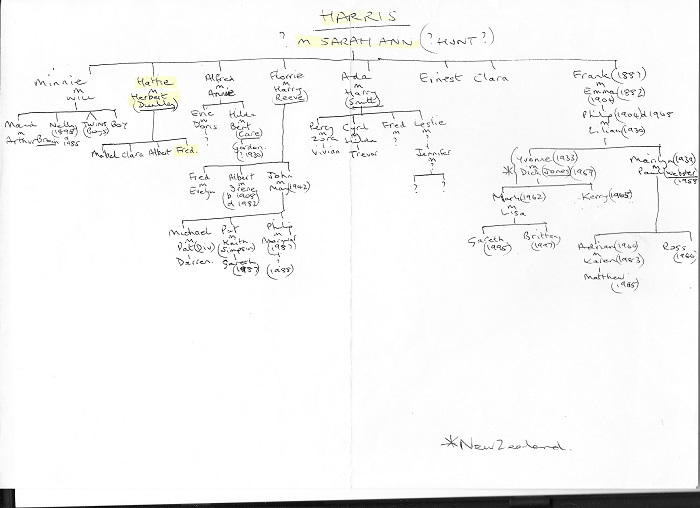
Although you can use research compiled by other people as a starting point in your journey, it is crucial to verify this information yourself. To discover more about how to determine if a family tree is accurate, please read my article: are family trees accurate?
If you find your relative has no interest in the family tree, it is always prudent to ask them if they have passed on their ancestor’s notes to the Local County Record Office. These notes could prove invaluable to your research.
If another person has compiled a family tree, they may have used abbreviations for crucial dates such as birth, marriage and death. I have written an article about the family tree abbreviations you may come across during the course of your research.
Number of Ancestors in 20 Generations
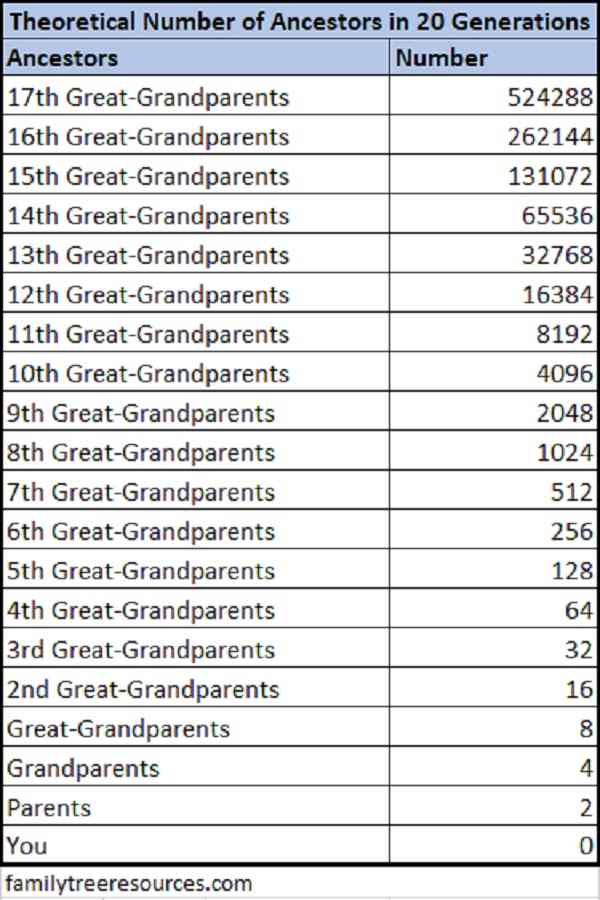
It is not easy to answer the question of how many ancestors you could unearth during the course of your family history research.
Although it is easy to simply use mathematics to answer this question, you will quickly come to realise that although we all know we have 2 parents, 4 grandparents and so on, the further back you go, the more complicated it becomes.
Taking that back through 1000 years of history, which would mean you would have to include many more generations than that mentioned in the chart above, you will find that you could have approximately 1 trillion ancestors, which is obviously impossible.
If you calculated that every ancestor you have had a child when they were in their mid to late twenties, it would become apparent that the mathematics may be sound, but that the numbers you reached would eclipse the total number of people who have ever lived, making it statistically impossible for you to have that many ancestors.
In earlier centuries, marriage was often between second cousins because the population was smaller, with people living in smaller communities.
People tended to marry in those communities and intermarriage was common, so you will discover that you are descended from the same individuals in many cases.
I have discovered that my ancestors Robert Cook and Catherine Peach(ey), who married on 8 November 1796 in Abingdon, Berkshire, are my 4 great-grandparents in two different ways because my research determined that their children Henry and Catherine both ended up marrying into the same family.
Henry Cook married Mercy Wilcox on 21 November 1819, having Sarah Cook in 1835 who married George Adams on 26 May 1864, while Catherine married James Adams, having George Adams in 1840. George was the man who married Sarah Cook on 26 May 1864.
Further Information For Starting Family History
You may decide that you would like to visit the area your ancestors came from – I have come across Britain Express – a great UK travel and heritage guide. If you wish to go on a genealogy research trip, there are many things you have to take into consideration. To read more about those, please read my article: planning a genealogy research trip.
If you ever hit a brick wall during your genealogical research, and are unsure of the best way to proceed, please read my article: 21 genealogy research tips to help you find your ancestors.
